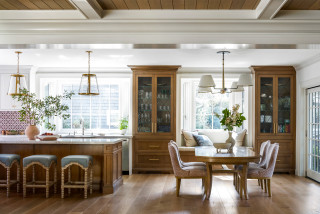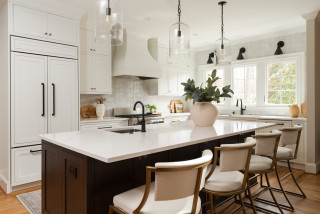
This article was originally published by a www.houzz.com . Read the Original article here. .

For many couples there’s often one person who’s more interested in decorating than the other. The other person might say, “Do whatever you want.”
Do not do whatever you want. Because as soon as you start buying things, Mr. or Ms. No Opinion will suddenly have an opinion. So make him or her spend some time with you at the very beginning just looking at pictures of interiors. “Spend an hour or two on the computer and look at some things together and talk about them,” says interior designer Alana Homesley of Woodland Hills, California. As you review each room, ask your partner, “What do you like about it? What don’t you like about it?”
Alternatively, you can each collect images independently, then sit down and compare what you’ve chosen. This way your initial selections won’t be swayed by the other person. As you review your selections together, your differences and similarities will immediately become apparent.
This article was originally published by a www.houzz.com . Read the Original article here. .

The Federal Housing Administration backs several home renovation loan options offered through private lenders.
If your renovation goal is to make your home more livable, useful, accessible or energy-efficient, you might qualify for a Title 1 fixed-rate loan. The maximum loan amount for a single-family home is $25,000, and amounts less than $7,500 are usually unsecured. The payout is a lump sum, and the interest rate is fixed.
If you need to borrow more than $25,000, you might qualify for a 203(k) loan (for major work). This combines a renovation loan with a mortgage. A portion of the loan goes toward purchasing the home, and the rest is paid to the contractor as needed. The interest rate can be fixed or variable.
This article was originally published by a www.houzz.com . Read the Original article here. .

The Federal Housing Administration backs several home renovation loan options offered through private lenders.
If your renovation goal is to make your home more livable, useful, accessible or energy-efficient, you might qualify for a Title 1 fixed-rate loan. The maximum loan amount for a single-family home is $25,000, and amounts less than $7,500 are usually unsecured. The payout is a lump sum, and the interest rate is fixed.
If you need to borrow more than $25,000, you might qualify for a 203(k) loan (for major work). This combines a renovation loan with a mortgage. A portion of the loan goes toward purchasing the home, and the rest is paid to the contractor as needed. The interest rate can be fixed or variable.
This article was originally published by a www.houzz.com . Read the Original article here. .

Now allow me to pinch you on the arm, because for most people, reality is often different from that idyllic scenario. You might see missing trim around the bedroom doors or wonder why that small change in the kitchen cost so much. Looking back, you might ask, “And why did we have to hire another subcontractor to finish the bathroom?”
Of course, there are things you just can’t plan for, but there’s plenty that you can. Costly changes and additional time-consuming work can be kept to a minimum if you fully understand what you are building before you start. By understanding the construction process, being part of the team and keeping a firm grip on the budget, your construction project can result in the home of your dreams.
This article was originally published by a www.houzz.com . Read the Original article here. .

A schedule is more than just a start and end date. Having a schedule that outlines tasks and timing will give you a big-picture view of sequencing and deadlines for things such as tile and countertops. It will also give you a benchmark so that you know if things are slipping by a day or two.
With small projects such as kitchens and bathrooms, schedule is everything. The cabinet lead time determines the start date and sub-trades need to be scheduled in quick succession, for instance. Don’t start without a schedule that tells you what days and times workers will be on-site.
2. Who Will Be Here Every Day?
Depending on the size and structure of the company you hire, the answer could vary widely. Many remodelers use a lead carpenter system, where a staff member (sometimes called a superintendent) is responsible for day-to-day work on-site, and often swings a hammer as well. Ask your contractor direct questions about who will be responsible for opening and locking up, who will supervise subcontractors on-site and whom to call on a daily basis with any questions.
Find a general contractor near you on Houzz
This article was originally published by a www.houzz.com . Read the Original article here. .

Start by setting a target date for construction, then give the homeowners clear instructions on how to prepare for their remodel. “Depending on the project, a homeowner may need to remove all items from kitchen or bathroom cabinets, or any other furniture that we’ll need to move to lay floor tile, for instance,” Palacio says.
It may be helpful to have a pre-construction meeting with the client, during which you discuss safety concerns, noise tolerance and limited access to living space. “We talk about where they are going to live and work during our planning process, and about how they will prepare to pack and move their belongings,” Bettinger says. Her team also sends clients a document with more details on how to prepare for construction.
This article was originally published by a www.houzz.com . Read the Original article here. .
If you’re going to take the time to photograph your projects, make sure everything is covered. If only one part of a room is visible, for example, the project won’t be seen in its entirety.
Solution: Provide a comprehensive shoot list for your photographer to ensure they snap everything you want to showcase. Consider, too, whether you’d like your project to be featured editorially, as there are often some minimum requirements. On Houzz, for instance, an article about a full house or condo project requires, at minimum, images of the kitchen, living area, a bedroom and a bathroom. A room tour on Houzz requires multiple photos of the space.
Find a professional photographer near you